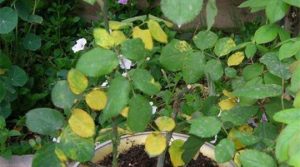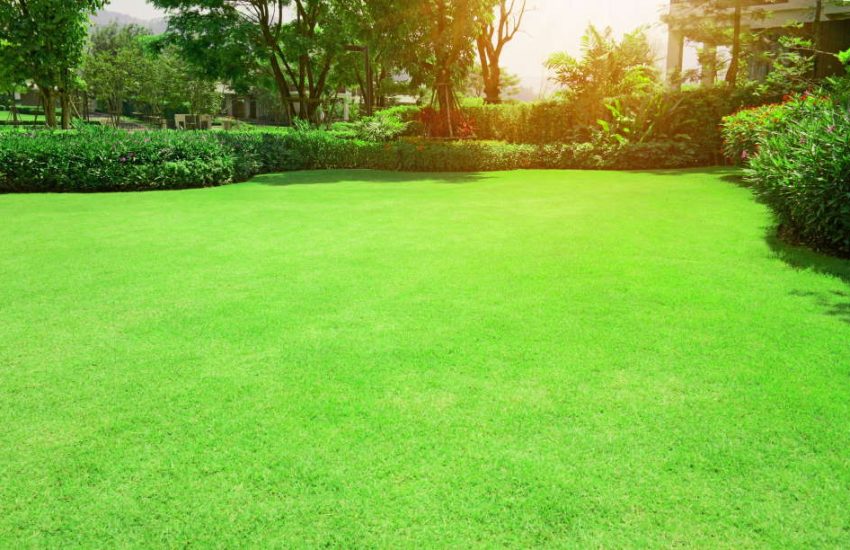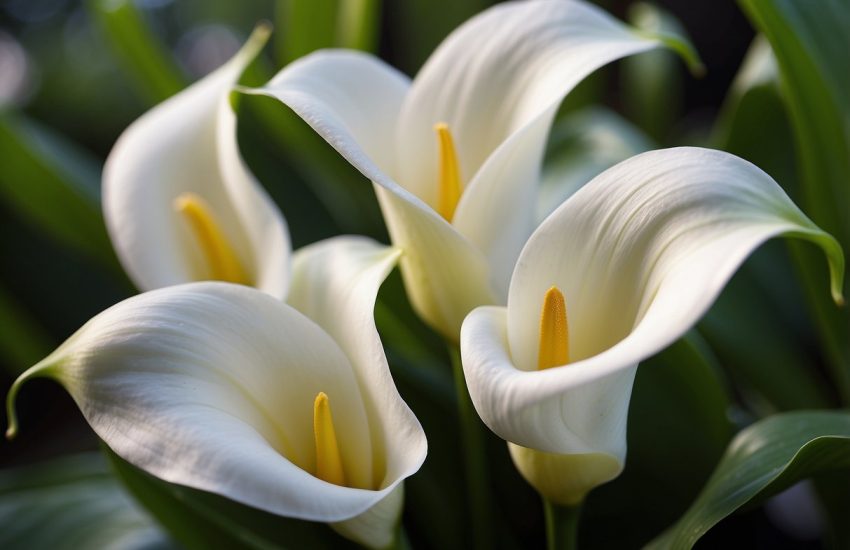7 Reasons Why Jasmine Leaves Turn Yellow
Tender and exquisite with gorgeous flowers, jasmine has an exceptional tropical fragrance. The plant thrives best in well-drained water and sunlight. It can also survive in a less-than-ideal garden or container. The leaves of a healthy jasmine flower are dark green with freckled shades of white.
You can cultivate the plant in different conditions. But, environmental, nutrition, and pest problems can turn the murky green foliage yellow. Keep reading to discover the causes of yellowing and their corresponding solutions. So, why do jasmine leaves turn yellow.

1. Problems with Irrigation
Improper watering impacts the health and well-being of your jasmine flower. The practice turns their foliage to yellow. Some of the irrigational issues that can affect your jasmine plants include:
- Excessive watering
- Underwatering
- Waterlogging
- Water Stagnation
Excessive Watering
When you apply too much water to the plant, it causes the jasmine to shrivel up. The withering causes the jasmine to become susceptible to fungal infections. It also causes root decay. As result, the conditions change the foliage to yellow.
Excess water affects the circulation of air and nutrients into the roots of the plant. If not rectified, the upper components of the flower begin to starve and then die.
How can you know if you are overwatering your jasmine? There are several signs overwatering your jasmine and they include:
- Sagging
- soft stems
- Yellowing of leaves
- Leaves falling off
- Sponginess in the soil
- Soil releases water when pressed
- Brown and corky bumps appear
Underwatering
When your jasmine gets too little water, the plant begins to wilt. Without adequate water, the leaves do not only turn yellow, they also drop off from the shrub.
The lack of water results in the wrinkling of the leaves. Eventually, the effect leads to drooping and loss of strength.
So, if a severe drought affects your flowers, they will need extra water. Remember not to overwater them. Instead, it will be vital to immerse the whole container into the water for several minutes. Let the extra water clear out.
Waterlogging
Waterlogging involves adding excessive water to the root part of a plant. The outcome involves the lack of an efficient gaseous exchange. Do not keep jasmine flowers in extremely humid conditions. Soaking it in water for extended periods is also dangerous. Their leaves begin to become yellow.
Water Stagnation
Water stagnation is a danger to jasmines especially when you cultivate them in a pot. It suffocates the roots and thwarts their nutrient absorption abilities.
The best approach for frequent watering your jasmine plants is to do it at spaced intervals. Thus, during the warmer seasons, water your potted jasmines once every three days. It provides them with enough water to keep them safe.
During the colder months, your houseplants will only require weekly watering for survival. Remember to place them indoors in a slightly shady area.
2. Pests and Insects
Certain insects with soft black scales munch on the leaves and succulent buds of jasmine. The tiny leveled culprits lack a noticeable head. When their insect colony attacks your jasmines, they feed on all the vital juices of the shrub.
The damage that stems from the feeding affects the plant. It results in flecking, fizzing out, and yellowing of jasmine foliage. Some of the pests that can affect your jasmine plants include:
- Scale insects
- Mealybugs
- Spider mites
Scale Insects
Scale/black-scale are small juice-sucking pests. They stick themselves to jasmine stalks and leaves. You can recognize the pests by their protective coating. The covering can either be wax-like or looks like a rigid shell based on its form of scales.
Mealybugs
Like scale insects, mealybugs are tiny. You can identify them using their wax-like, granular, or cotton-like cover. The pests cause the yellowing of jasmine leaves. They chomp on the succulent components of the flower and leave it to die. If your small plants get infested with destructive bugs, you can eradicate them. You will need to use a toothpick or handpick to eliminate them.
Spider Mites
Spider mites will also feed on the sap in your jasmines and leave them affected. The insects hide underneath the leaves, causing them to become yellow. If you notice spider mites on your shrubs, applying potash soap might be a great solution. Spray the jasmine with the product at least three or four times across five days to a week.
3. Mineral Deficiency Problems
Jasmine thrives well in conditions with essential nutrients. The minerals required include iron, zinc, and magnesium.
Without essential nutrients in the soil, jasmine leaves start to fade. Besides, their color changes to yellow. As a result, the overall health of the plants deteriorates.
Besides, if the color of jasmine leaves starts to change to yellow, it could show a nitrogen deficit. The deficiency happens when the soil starts to leach. Excessive water in your plants reduces nitrogen levels. Nitrogen reduction affects photosynthesis, thus slowing the plant’s growth process.
Chlorosis is a nutrition-related problem. It stems from the lack of nutrients in plants. The condition can lead to stunted growth. It also causes paling, and yellowing of leaves based on the intensity of the deficit. When this happens, you may use a foliar spray as a short-term solution. A professional soil test will be vital under such circumstances. The process determines the specific minerals lacking in the soil.
4. Fertilizer Problems
Too little to no fertilizer in your soil affects your jasmines. It clumps up the roots of the plants, preventing the absorption of nutrients. Similarly, excessive fertilizing of the soil can cause the jasmine leaves to turn yellow. Nourishing the solid with just the right amount of minerals is crucial. Performing a soil test will help you to know the nutrients it lacks.
In some cases, the soil may contain the appropriate nutrient levels. However, root infections, roundworms, and excessive watering can hinder its health. They prevent the plant from accessing the nutrients.
If the jasmine leaves start yellowing, contact a specialist for a professional analysis. An expert will determine why the nutritional components do not nourish the plant. Besides, you can use foliar sprays instead of granular fertilizer. The spray provides crucial nutritional value to the leaves fast.
5. Acidity Levels
The health of jasmine leaves significantly depends on the PH levels of the soil. If the alkaline levels of the soil increase, jasmine leaves slowly change to yellow and start to come off. Alkalinity affects the capacity of the plant to gain vital minerals. Without iron and manganese, the yellowing begins to happen.
Acidic soil conditions in which jasmines flourish the best range from 4.8-8.3. A soil test can show levels that surpass normal constraints. If it happens, you need to adjust the alkalinity to achieve a suitable acidic range.
One of the best solutions for reducing the alkalinity of the soil is to encircle the jasmine with sulfur. Organic matter also helps. Maintaining the soil PH at 6.5 or lower helps to avail iron to the plant. If the PH level drops beyond the required parameters, adding lime helps to increase it.
6. Light and Temperature Problems
A warm environment provides the best mechanism for jasmines to flourish. However, exposing it to excessive sunlight can cause its leaves to yellow. The flower should not be in an area that is too hot or too humid especially when you grow them in pots.
Make sure to place your flowers in a place with well-scattered sunlight. You have to maintain proper indoor distribution and cooling to protect your flowers.
Extremely low temperatures can also cause jasmine leaves to turn yellow. The temperatures of your house should not reduce to up to three degrees Celsius. During the winter, make sure to keep your potted jasmine indoors.
7. Natural Aging
Yellowing of jasmine leaves can also result from natural aging. Like any other plant, the flower has a specific lifespan, and its waning kicks in over time.
In most cases, yellow jasmine leaves can be the cause of alarm. However, the yellowing can naturally occur during the fall season right before the winter break. If you notice the loss of the dark green shade and dying in some leaves, the jasmine will continue to grow normally.
The flower naturally sheds its leaves before the winter months can set in. Thus, if you do not notice any disturbing changes, it is likely to be a perfectly natural experience. Wilting and withering of undeveloped leaves are a sigh that should concern you.
Solutions for Yellowing Jasmine Leaves
The type of remedy that works on yellow jasmine leaves depends on the cause of the problem.
Proper watering: Yellowing results from overwatering. The lack of water can also cause problems. Practicing proper watering will be vital. The best way to make sure your jasmines have access to efficient water is to maintain a moist condition. The water should never pile up in the container or ground soil.
During the hot months, frequent watering of your jasmine is vital. It prevents its leaves from turning yellow. Do not place the plant in a dark environment it can affect it too. Putting your jasmine in a suitable environment (neither too hot nor too cold) helps to keep it healthy.
Proper Soil Drainage: Create a draining system to allow efficient water absorption. The drain system will clear out the excess water from the plant.
Flipping the Soil: If the soil has excessive water, use a spade to turn over the soil and allow free air circulation. When flipping the soil, be cautious and gentle enough to avoid tampering with the roots.
Avoid over-fertilization: Shift the soil in your jasmine pot early enough. Flipping can resolve the overfertilization problem. Frequent application of low fertilizer is also vital. It helps to supply the flowers with standard nutritional value.
Micronutrient-rich fertilizers: A soil test reveals nitrogen deficiency as the cause of yellowing. Whirl and spin the soil around to mix its contents. You can also feed it with extra nitrogen fertilizer.
Fertilizers that are rich in phosphorus and potassium can resolve the issues. When you add both nourishments, it stops the yellowing of leaves and the jasmine flowers to bloom.
Maintain acidic soil levels: Jasmine grows in acidic conditions. It thrives even better with adequate iron. So, supply the plant with adequate iron nutrients. It facilitates the growth of healthy green leaves, blossoms, and floras.
Pest Treatment: Are your jasmine leaves turning yellow due to a pest infestation? You can treat a mild pest problem using insecticidal soaps and gardening oils. However, if your pest problem persists, contact professional pest removal experts for help.
Tips for Planting and Growing Jasmine
You can grow jasmine in potted containers, suspended baskets, or in your garden. If you want to grow jasmine, you have to know the best conditions under which it flourishes. Here are the crucial things that you should know about taking care of your jasmine garden or pots.
Best time to plant: The best time to plant the flowers is from June to November. Plant your potted jasmines during the fall season for the best outcomes.
Perfect Location: Jasmine grows well in places with adequate access to sunlight. The summer-flowering species especially flourish in sunny conditions. If you want to grow the winter jasmine, a slightly shady space will be perfect.
Soil Required: Well-drained nutrient-rich soil helps the plant to achieve a healthy bloom. Moderate fertility and moisture are also crucial for the plant.
Plant Spacing: Plant your jasmine flowers at 8-feet intervals. You need to provide enough space for the healthy growth of its roots. Besides, adequate spacing of the flowers gives them a tremendous glow.
Pruning: Remember that the flower is a climbing vine. Once the flowering process begins, prune the older sprouts. It helps to shape the jasmine, especially during the spring season. You need to secure its stems to a strong support system.
Fertilization: Add potassium and phosphorus fertilizers to the plant. Repeat it after every six months for healthy growth.
Conclusion
Any harsh conditions or deficiencies can affect well-being of jasmine. Too much or too little water, nutrients, or sunlight, brings about various problems. The same case applies to the yellowing of jasmine leaves. Therefore, you need to pay adequate attention to the plant. Jasmines are low-maintenance especially when you grow them in the right environment.


